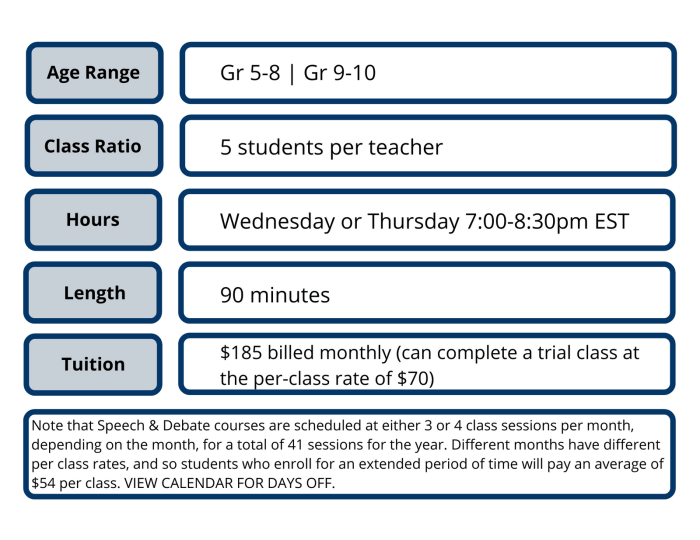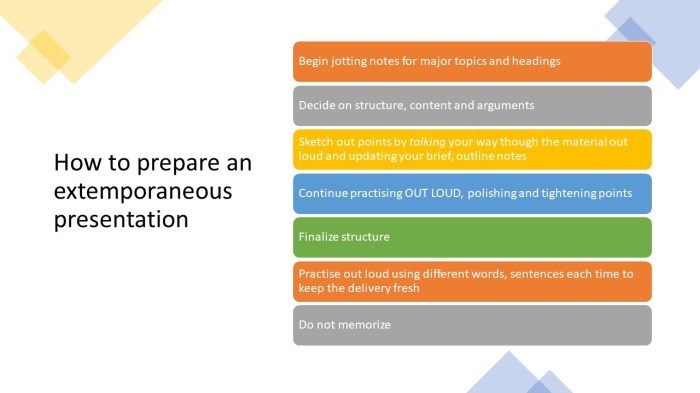When practicing a speech for extemporaneous delivery speakers should practice – When practicing a speech for extemporaneous delivery, speakers should practice, practice, practice. Extemporaneous delivery is a form of public speaking that falls between impromptu and manuscript speeches. It requires speakers to be well-prepared and organized, but it also allows them to speak in a more natural and conversational way.
As a result, extemporaneous delivery can be a very effective way to communicate with an audience.
There are many benefits to practicing extemporaneous delivery. First, it can help speakers to develop their confidence and poise. When speakers are well-prepared, they are less likely to be nervous or anxious about speaking in front of an audience. Second, practicing extemporaneous delivery can help speakers to improve their organizational skills.
When speakers have to think on their feet, they need to be able to organize their thoughts quickly and clearly. Third, practicing extemporaneous delivery can help speakers to improve their delivery skills. When speakers practice, they can work on their pacing, volume, and tone of voice.
They can also practice using gestures and body language to enhance their delivery.
The Importance of Practice for Extemporaneous Delivery

Extemporaneous delivery is a type of public speaking where the speaker has minimal preparation time and relies heavily on their ability to think on their feet. While this type of delivery can be challenging, it is also a valuable skill to master.
With practice, speakers can learn to deliver speeches that are both informative and engaging.There are several benefits to practicing for extemporaneous delivery. First, practice helps speakers to develop their ability to think quickly and clearly. When speakers have to think on their feet, they need to be able to organize their thoughts and ideas quickly and efficiently.
Practice helps speakers to do this by providing them with opportunities to rehearse their speeches and to become more comfortable with the process of speaking extemporaneously.Second, practice helps speakers to improve their delivery skills. When speakers practice, they can focus on improving their vocal projection, articulation, and body language.
They can also practice using different techniques to engage their audience, such as eye contact, gestures, and humor. By practicing their delivery skills, speakers can become more confident and effective when they are speaking extemporaneously.Third, practice helps speakers to develop their knowledge of the topic they are speaking about.
When speakers practice, they need to research their topic thoroughly in order to be able to speak about it in an informed and engaging way. This research process helps speakers to develop a deeper understanding of the topic, which can make them more confident and effective when they are speaking extemporaneously.
Techniques for Effective Practice: When Practicing A Speech For Extemporaneous Delivery Speakers Should Practice

There are a number of different techniques that speakers can use to practice for extemporaneous delivery. One common technique is to use a structured Artikel. A structured Artikel is a roadmap that speakers can use to organize their thoughts and ideas.
It typically includes a main point, several supporting points, and a conclusion. By using a structured Artikel, speakers can ensure that their speeches are well-organized and easy to follow.Another common technique is to use note cards. Note cards can be used to jot down key points, quotes, or statistics that speakers want to include in their speeches.
Note cards can be helpful for speakers who need to remember a lot of information or who want to have a visual cue to help them stay on track.Finally, speakers can also practice by recording themselves and then listening back to their recordings.
This can help speakers to identify areas where they need to improve their delivery skills. Speakers can also ask friends or family members to listen to their recordings and provide feedback.
The Role of Feedback in Practice
Feedback is an essential part of the practice process. Feedback can help speakers to identify areas where they need to improve their delivery skills. It can also help speakers to develop a better understanding of their audience and what they are looking for in a speech.There
are a number of different ways to get feedback on your extemporaneous speeches. One way is to ask a friend or family member to listen to your speech and provide feedback. Another way is to join a public speaking group or club.
Public speaking groups and clubs provide a supportive environment where speakers can practice their speeches and get feedback from other members.
Strategies for Overcoming Challenges

There are a number of common challenges that speakers face when practicing extemporaneous delivery. One challenge is the fear of forgetting what to say. Another challenge is the fear of making mistakes. Finally, speakers may also find it difficult to stay on track and to keep their speeches within the time limit.There
are a number of strategies that speakers can use to overcome these challenges. One strategy is to practice regularly. The more speakers practice, the more confident they will become in their ability to think on their feet and to deliver a successful speech.
Another strategy is to prepare thoroughly. Speakers should research their topic thoroughly and develop a structured Artikel before they begin practicing. Finally, speakers can also use note cards to help them stay on track and to remember key points.
Incorporating Technology into Practice

Technology can be a valuable tool for speakers who are practicing for extemporaneous delivery. There are a number of different technological tools that speakers can use to improve their practice sessions.One type of technological tool that speakers can use is a speech timer.
A speech timer can help speakers to practice staying within the time limit for their speeches. Another type of technological tool that speakers can use is a video camera. Speakers can use a video camera to record themselves and then listen back to their recordings.
This can help speakers to identify areas where they need to improve their delivery skills. Finally, speakers can also use a variety of software programs to help them with their research and to organize their thoughts and ideas.
FAQ Corner
What are the benefits of practicing extemporaneous delivery?
There are many benefits to practicing extemporaneous delivery, including increased confidence, improved organizational skills, and enhanced delivery skills.
How can I practice extemporaneous delivery?
There are many ways to practice extemporaneous delivery, including practicing with a partner, recording yourself, and giving speeches in front of a small audience.
What are some tips for delivering an effective extemporaneous speech?
Some tips for delivering an effective extemporaneous speech include being well-prepared, organized, and confident. Speakers should also practice using gestures and body language to enhance their delivery.